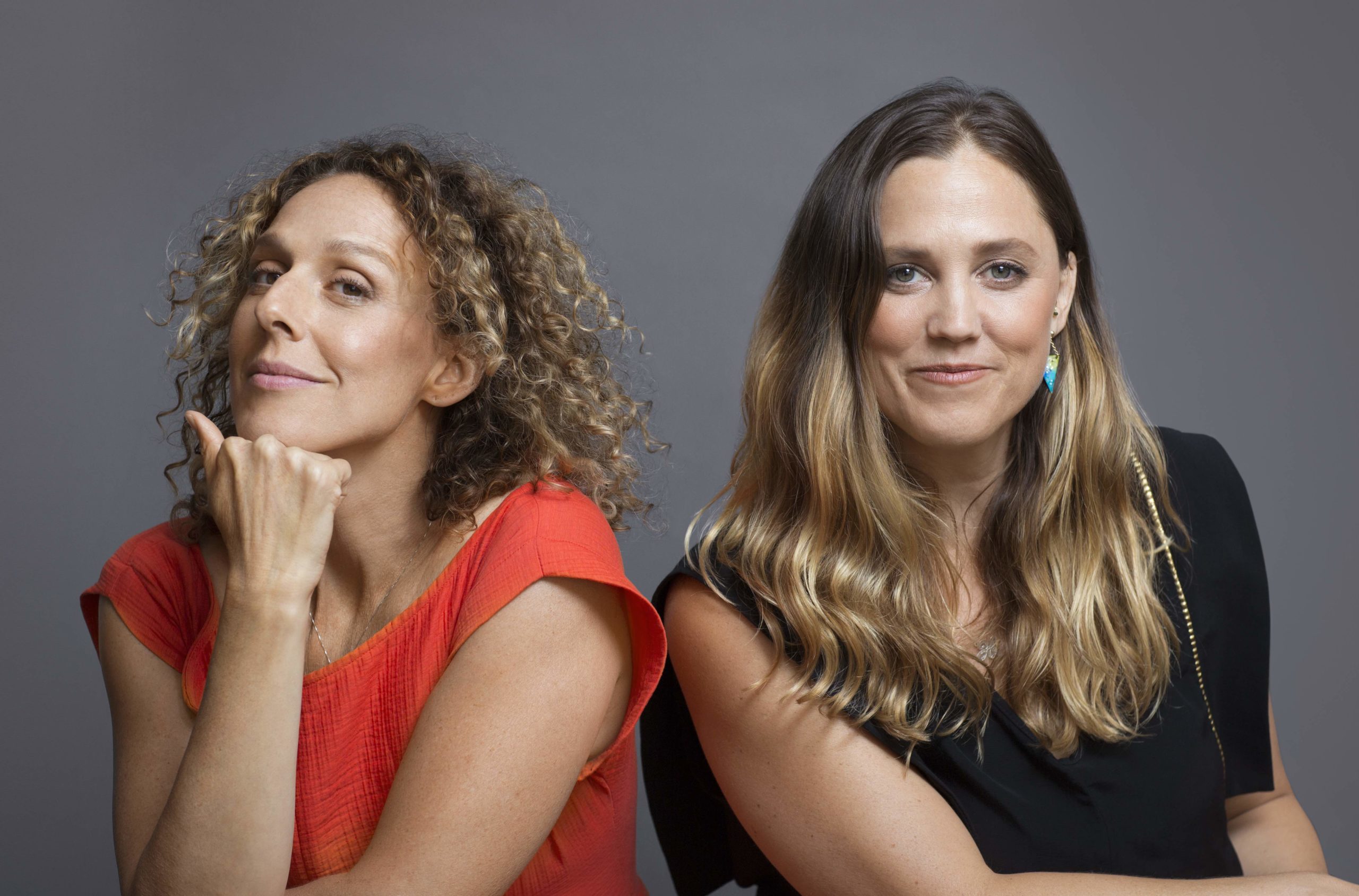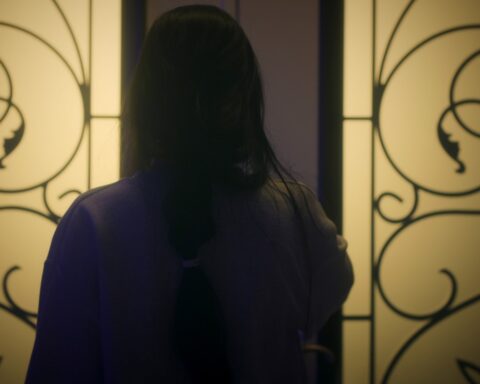Rachel Grady and Heidi Ewing, the directors of the Oscar nominated Jesus Camp, return with another gripping and eye-opening study of an insular community. One of Us puts the filmmakers on a riveting journey alongside three individuals—Etty, Luzer, and Ari—as they escape the suffocating confines of New York’s Hasidic community. The film is remarkable in its ability to unfold with suspenseful unpredictability as Grady and Ewing observe these three New Yorkers at various stages of their transition. What emerges is a complex and multifaceted unpacking of the roles and structures that enable faith to guide our lives. Read the POV review of One of Us here.
POV sat down with Grady and Ewing on the day of the film’s world premiere at the Toronto International Film Festival this September. The pair was whisked into the conference room of the Shangri-La (just next door to a meeting room where Angelina Jolie was holding court) after rushing out of the premiere of Brett Morgen’s new film Jane, inspired and invigorated to talk documentary.
One of Us is one those cases where the less one knows about it going in the better—and we can assure readers that Netflix didn’t impose any Blade Runnery spoiler embargoes—but it’s a film from which urgent universal topics emerge from these three stories set in a tightly restricted and specific community. It’s a treat to see the filmmaking duo, whose films also include Detropia and Norman Lear: Just Another Version of You, in action together. The pair buzzed while talking passionately about their subjects and the suspense of accompanying them along their journeys, finishing one another’s sentences harmoniously while extending the conversation to politics, craft, the changing landscapes of news media, Netflix, and, finally, the Oscars—where the pair just might find themselves in the running with Mr. Morgen.
RG: Rachel Grady
HE: Heidi Ewing
POV: Pat Mullen
This interview has been edited for brevity, clarity, and the removal of spoilers.
POV: How did you find your subjects? Your film shows us that members of the Hasidic community don’t have access to technology, so they presumably wouldn’t be familiar with your work or be able to Google you.
RG: We found them through the organization Footsteps. [Footsteps assists members of the Hasidic community with the departure and transition to the secular world.] We wouldn’t have been able to find them any other way, so we talked Footsteps into letting us meet their clients. That took about six months. They eventually said “yes,” and then we hung out in their waiting room. It took another six months to narrow down which subjects we wanted to film.
HE: It was at least a full year of casting and access before we honed in on the three people you see in the film.
POV: What did it take to convince them to share their stories with you? So many aspects of their lives are at risk.
HE: We don’t try to “convince” people to be in our films. Especially in a situation like this, you talk to people, you get to know them, and you explain what you’re doing and why you’re telling the story. You hope to find people at a point in their lives where they want to share their story; where they see value in what’s happening to them for other people who might not be content with their lives. We didn’t do any really hard selling because there’s a lot that could be lost [for them] in terms of family relationships. Some people think they’re going to leave and they choose to stay. There were several people who wanted to participate in the film but we actually felt they weren’t really ready to participate.
RG: People who were too vulnerable.
HE: Everyone you see in the film was actively empowered and very gung ho about sharing their story.
POV: There’s a strong sense of catharsis to the stories in the film.
RG: Exactly. It gives them agency. Not that we would ever tell someone that we know what’s better for them. People don’t always realize the impact that sharing your story has with the world and how that changes you. It’s very fragile, this transition, so we wanted to make sure we found people who could speak to one another. Our characters also left for different reasons. It’s not a “monolithic exit.”
POV: The range of stories is so compelling—overwhelming at times when you see the gaps between the luxuries you enjoy and the things that might be denied in another community.
HE: We make films about specific communities, lifestyles, and people, but we are always looking for stories where we can pull back and let greater universal themes emerge. This film falls into that practice in a sense that anyone, whether they’ve met a Jewish person or know the word Hasid, has felt a need to break away from their family, friends, community, or faith and stride out on their own into the wider world. I think that anyone, regardless of their religious practice, can find some commonality with these characters.
POV: I really liked watching One of Us as a companion piece to Jesus Camp. What did that film teach you about dealing with such sensitive issues as faith? One of Us does a very good job of showing that faith isn’t the issue, but rather—
RG: —the community and apparatus. We really saw a direct line between this film and that film in terms of not just filmmaking, but what we’ve learned about human nature—how tied people are to faith as a source of identity and belonging. When we started making One of Us, we saw that these characters could have been the same kids from Jesus Camp when it’s ten years later and they have agency. What do they decide to do? Where do they go? It built on the themes that we really enjoyed exploring.
POV: The film is very timely. What responsibilities do documentaries have right now? Every piece on the docs can’t avoid the relationship of Trump, “fake news,” and documentary.
HE: We have a greater responsibility than ever as documentary filmmakers. Ten or fifteen years ago, you saw the closure of newsrooms beginning around the world and documentaries started to fill some of that void that was no longer being explored by print publications. That’s evolved a lot now because there are citizen journalists looking for greater audiences and turning to documentary filmmakers to help them tell their stories. We have to stick with it, get in there, follow our gut, and have the patience to uncover and explore worlds, characters, and themes so that there’s just no time for in the Trump era. The news media can barely keep up every day between this Tweet and the next, so I think the patience it takes to make a documentary, the focus, and the deep dive are all really important right now.
POV: How can media and documentary work together?
RG: I would love to see more partnerships.
POV: New York Times Op-Docs is a great one.
HE: I wish there were a more efficient pipeline where we could all share ideas.
RG: Do you know ProPublica? It’s a wonderful organization of investigative journalists. It’s outside the mainstream and they do very deep, thorough, excellent investigative journalism, and when appropriate, they share all of the findings with filmmakers, with 60 Minutes, and with whomever. It is an unofficial relationship that works great.
HE: We’ve come close to making films based on some of their reporting. I think a lot of filmmakers are looking for these relationships.
RG: It seems to be a way to pool resources. They don’t work with music!
HE: Or cinema!
POV: In the TIFF programme, Thom Powers calls One of Us a thriller and it really is one. Can you talk about developing the look, pace, and using things like music to further the story?
RG: The story always has to come first in terms of your stylistic approach. You have to do what makes sense and is appropriate. Etty’s story took us in that direction because everything was happening in real time while we were filming. It felt like we were on this fight with her. It did very much feel like a mystery, a thriller. It was scary and we were very nervous about the outcome. It ended up being the direction that we took creatively because the story told us it needed to be.
HE: You try to bring the audience on the ride that you had making a film. You try to imitate the feelings you had and the experiences of the character. That genre, at least in terms of Etty’s story, is spot on for the way her year was going.
POV: Her story is so gripping because you get such a glimpse at the way the community pushes back when she tries to leave. Did you experience any pushback from the Hasidic community while making this film?
RG: They just found out, so not yet! We’ll see.
HE: We weren’t advertising it.
RG: We’ll see. There will be some pushback.
POV: And how do you expect to—
RG: —deal with it? I am open and wiling to have any conversation they’re interested in having.
POV: And I think the film shows that with how it ends with Ari’s mentor, Yosi. Was it difficult to have an active member of the community in the film?
RG: It took quite a while for him to agree to be in the film. By design, they don’t want to share their feelings or experiences with outsiders.
HE: They don’t enjoy when cameras or media take an interest.
RG: We struggled for several years and I think it makes the film and community more complex. Yosi is a very loving person and we were able to give that aspect to the community in the film.
POV: We see a lot of campaign signs for Trump in the film. What was the dynamic in the community while filming with Hillary Clinton running against Trump, a conservative anti-Semite?
RG: It is a very conservative community.
HE: They mostly vote Republican.
RG: In the end, they vote for who they think will be most sympathetic to their lifestyle and worldview. In this case, they went for Trump.
POV: Really?
RG: They went for Trump.
HE: Also, his daughter is a convert. I don’t know how much that matters, but this time around there were votes for Hillary Clinton. I don’t think the community split, because the Clintons do have a history with the community.
RG: When she was a senator.
HE: It wasn’t cut and dried this time.
RG: But Crown Heights [the neighbourhood depicted in the film] was for Trump.
HE: The bottom line is that the real actions in the political life from Borough Park to north Brooklyn for the Hasidic community are the local and hyper-local elections. They care very much about the local representatives, like the judges, which in New York, are elected not appointed.
RG: Some are, some aren’t.
HE: In this case, they take an avid interest in their specific surroundings. The national election, really, wasn’t as big of a deal. You see a lot more signs for the local elections for city council, congresspersons, etc.
POV: And that allows the isolation of the community to continue.
RG: They’re electing people who will protect their lifestyle, as any well organized and efficient community does, just like in Jesus Camp.
HE: They know exactly who’s going to advocate for them and who’s not. They make it known to the candidates that they vote as a block.
RG: They’re not shy about that.
HE: If you’re a politician in New York City or New York State, you will deal with the Hasidic community at some point. They make themselves known because they want to protect and defend their interests, which every wonderful community has the right to do.
RG: There aren’t enough of them to have an impact at the national level.
POV: Which is interesting that it’s such a small community that has endured and, in certain ways, been enabled by some serious systemic flaws. Like watching the scene where the court transcript plays out, that might not happen were they discussing Islam in the States. What’s the future in terms of that larger change for secular courts?
HE: The relationship between church and state in the United States is a very tenuous line that we’ve been walking since the Founding Fathers. In this case, the Hasidic community has really figured out the Status Quo. It’s not a law, but a—
RG: A standard.
HE: —a standard where they’ve figured out how to bring in the religious piece and, through much study and work with lawyers, have learned how to have judges apply that status quo to questions of religion raising children. Footsteps would tell you—and they’re very experienced with divorce cases—that we really need to bring to the public this particular loophole. Judges don’t understand that there’s more latitude on the status quo than it appears to be. It seems onerous to force a woman to wear a wig or wear in front of her children the robe of a religion she no longer practices in order to keep them with her. It’s a dark unknown corner of the law that’s being taken advantage of quite expertly by the Hasidic community.
RG: But, just two weeks ago, a precedent was established when the same lawyers, the same judge, the same team and the same kind of case was overturned on appeal based on the question of how a person can be held up to this inappropriate standard.
HE: Hopefully the film educates people, not just in the Hasidic community because it is applied through other religious practices. It’s an interesting corner of the law that we were not aware of before we started filming Etty.
POV: And with the aspect of educating people and reaching audiences, can you talk a little about working with Netflix? This film is your first production with them as the industry is changing so much with digital. Are you optimistic about the way things are going for documentary?
RG: I’m optimistic in that there are more outlets, options, funding sources, and interest. It’s just growing. For us as filmmakers who have been doing this for a few years and are on our sixth feature film, it’s great that as we grow as filmmakers, so does the industry.
HE: When we started making films, people didn’t have the option to just go out and pick a documentary or stay home and choose a documentary. That [availability] didn’t exist, so you had to plan, find it, seek it out, or see it on PBS. It’s an incredible explosion right now. I know people who are happy to click around and choose something that sounds interesting. Netflix seems to have gotten seriously behind the genre and they were extremely supportive of our work. So far so good.
POV: Netflix has also had success breaking into the Oscar race for streaming sites. You’ve been in the race before [Jesus Camp was nominated for 2006 Oscars and the short The Education of Mohammed Hussein made the 2012 shortlist] and I suspect will be again, but it’s really changed with the campaigning over the years. How do you stay ahead of the pack?
RG: Yes, it’s pretty competitive now! We try to make really good films and that’s all we can do. People are getting better and the quality is improving.
HE: That’s the biggest change: there are just a lot more better films.
RG: Which is great. Everyone makes us up our game, care more and push harder. It’s great to be in the company of great talent. Especially in New York, we have a great community of filmmakers, like Brett Morgen, and I’ve been able to see many filmmakers grow and their films have become more daring. It’s so inspiring.
HE: Like Agnès Varda. It’s so inspiring to see her work. I hope we’re still making movies at 89 with that same energy. Go Agnès!
One of Us premiered at TIFF and screens DocNYC in November. It debuts on Netflix on October 20.
Read the POV review of One of Us here.











